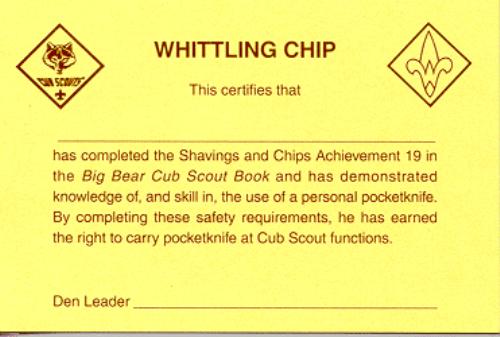
A Whittling Chip card is issued to a Bear or Weblos Cub Scout to show that they have had and passed the necessary trainign to carry and use a pocketknife at certain Scout activities. The Den Leader will let them know when a pocketknife is needed, the Cub Scout should check with the Den Leader to find out if a pocketknife will be needed or allowed at each activity. If the Cub Scout is not sure, don’t bring it.
In return for the privilege of carrying a pocketknife to designated Cub Scout functions, the Cub Scout agrees to the following:
- I will treat my pocketknife with the respect due a useful tool.
- I will always close my pocketknife and put it away when not in use.
- I will not use my pocketknife when it might injure someone near me.
- I promise never to throw my pocketknife for any reason.
- I will use my pocketknife in a safe manner at all times.
Akela (any leader, parent, or adult) can ask for the Whittling Chip at any time a Cub Scout has a pocketknife in his possession. If the Cub Scout does not have the card in his possession, the knife is to be collected and returned to the parent.
The Whittling Chip does not allow a Cub Scout to bring a pocketknife onto school property at any time, even when school is out. Having a pocketknife on school property, will result in loss of the Whittling Chip card and possible expulsion from school. It can not be earned back in our pack.
An accident which results in another person being injured will also result in loss of the Whittling Chip card, it can not be earned back in our pack.
Violation of a safety rule may result in having a corner torn off the card or temporary loss of the card depending on the seriousness of the violation. If all four corners are torn off, the Cub Scout must earn the card again by taking another class.